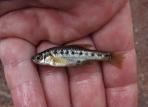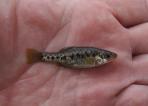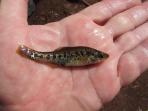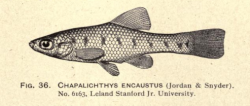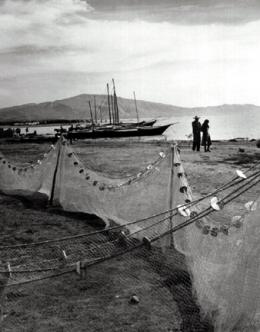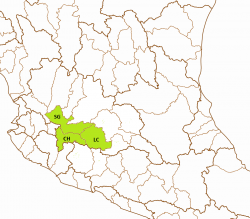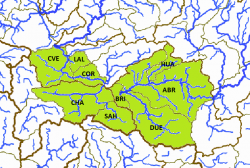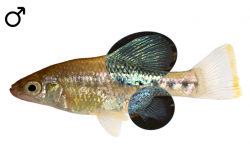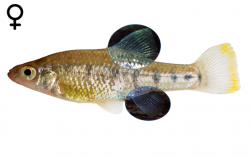Chapalichthys encaustus
JORDAN, D. S. & J. O. SNYDER (1900): Notes on a collection of fishes from the rivers of Mexico, with description of twenty new species. Bulletin of the United States Fish Commission. 1899: pp 115-147
Collection-number: Leland Stanford Jr. University and Museum, Cat. No. LSUM-6163.
The Holotype is an adult female, the standard length was not measured by the author. The type was collected by J. O. Snyder on December the 26th, 1898.
The left picture shows the first drawing of the Holotype of Chapalichthys encaustus:, the right one points on the importance of the Barred Splitfin in human consumption and shows typical fishermen devices and boats at the Chapala lake in 1941, taken by the famous US photgrapher Ernest Knee (1907-1982):
The Holotype was caught in the Lago de Chapala near Ocotlán, federal state of Jalisco.
The epithet goes back to the ancient Greek and "énkaustos" (ἔγκαυστος) with the meaning “burnt in”. It can be derived from "én" (ἐν), which means "in", and "kaustós" (καυστός), “burnt”, from "kaíō" (καίω), “I burn”. Jordan and Snyder chose the name probably due to the lateral stripes of adult fish, which look like brand marks.
The generic name goes back to the year 1902 and Seth Eugene Meek. He didn't explain why he had chosen this name for Characodon encaustus, but most probably because of the type localition of this species, the Chapala lake. Chapala is for sure taken from the lakes name and the Greek word ἰχθύς (íchthús, íchthýs) means fish, so Chapalichthys can easily be translated with "Fish from the Chapala lake". The name of the Chapala lake itself is taken from the Nahuatl language and the lake is named to honor the last chief of the indigenous Aztec people, chief Chapalac, so in a more romantic way, you can say "the fish from chief Chapalacs lake".
Characodon encaustus Jordan & Snyder, 1900
The Barred Splitfin is endemic to the Mexican federal states of Jalisco and Michoacán. It is historically known from the lower Río Lerma drainage including the Río Lerma itself from about La Piedad and some affluents like the Río Duero and the canales dren Colesio, Zanja Madre and Moreño. It also occured in the Laguna de Chapala and adjacent sections of the Río Grande de Santiago to about the waterfalls at Juanacatlán E of Guadalajara, in the Laguna Cajititlán and a main affluent of the Laguna Chapala in the SW, the Canal Sahuayo including some dams in its headwaters (Presas Jaripo and Nueva). It disappeared from the ríos lerma and Grande de Santiago due to water pollution but still persists at most of the other places though sometimes in reduced numbers (Laguna de Chapala). Strongholds are the Lagos Los Negritos near Sahuayo and the dams around Jacona de Plancarte (Presas Verduzco and Orandino). The species can be found additionally in the Presa La Vega, upper Río Ameca drainage, but this is regarded as an introduced stock. The time and reason for the introduction are not completely solved. Though Chapalichthys were collected together with the types of Ameca splendens by Miller et al., in 1955 (Miller and Fitzsimons, 1971), it stayed almost unnoticed until the early years in this millenium when a single individual has been reported by P. Gesundheit in 2005 (Lyons, 2011). On a survey by Köck et al. in 2016, three adult fish were caught on the N end of the Presa La Vega. According to the affiliation to two river drainages, two subpopulations, the Laguna de Chapala (type subpopulation) and the Lower Río Lerma subpopulation, can be distinguished. The bold names are the ones officially used by the Instituto Nacional de Estadística y Geografía; nevertheless, other ones might be more often in use or better known and therefore prefered.
ESU ist short for Evolutionarily Significant Unit. Each unit expresses an isolated population with different genetic characteristics within one species. ESU's can be defined by Molecular genetics, Morphology and/or Zoogeography and help in indicating different phylogenetic lineages within a species. The abbreviation for an ESU is composed of the first 3 letters of the genus, followed by the first 2 letters of the species name and an ongoing number in each species.
In Chapalichthys encaustus, no different ESU's are distinguished, so all fish belong to Chaen1.
The left map shows the Lago de Chapala (CH), the Río Lerma-Chapala (LC) and the Río Santiago-Guadalajara (SG) basins from the Hydrographic Region Lerma-Santiago on a Mexico map. Within the Río Lerma-Chapala basin, the Barred Splitfin is known from the ríos Angulo-Río Briseñas (ABR), Briseñas-Laguna Chapala (BRI), Duero (DUE) and the Arroyo Huascato (HUA) subbasins. Further downstreams it can be found in the Laguna Chapala (CHA) and Río Sahuayo (SAH) subbasins from the Lago de Chapala basin, and in the Laguna Chapala-Río Corona (COR), Río Corona-Río Verde (CVE) and Río La Laja (LAL) subbasins from the Río Santiago-Guadalajara basin. All these subbasin are shown on the right map:
International Union for Conservation of Nature (IUCN): Vulnerable
Distribution and current conservation status of the Mexican Goodeidae (Lyons et al., 2019): Vulnerable/declining: „This species was formerly abundant throughout nearshore areas of Lake Chapala and was also encountered in adjacent areas of the lower Lerma and upper Santiago rivers and their tributaries (Lyons et al., 1998). Since the late 1990s, C. encaustus has disappeared from the mainstem Santiago and Lerma rivers due to pollution and has become much less common in Lake Chapala owing to the invasion of the non-native Poecilia sphenops and Gambusia yucatana (Poeciliidae) (Becerra-Muñoz et al., 2003). Chapalichthys encaustus still persists in the lower portion of the Duero River drainage, a Lerma River tributary, including the La Luz and Orandino lakes, and also in Cajititlán and Los Negritos lakes, both near Lake Chapala. Beginning in 2005, small numbers of individuals have been collected from the La Vega Reservoir and its outlet in the upper Ameca River basin (Mar-Silva, in press). These C. encaustus were probably introduced accidentally during a stocking of Oreochromis aureus (Cichlidae) from Lake Chapala or the Lerma basin.“
NOM-059-SEMARNAT-2010: no categoría de riesgo (no category of risk)
This fish lives in quiet waters of lakes, ponds and river channels, where currents are usually slow to none, but may be moderate. Vegetation is usually sparse to none. When there is vegetation, it is composed of green algae, water hyacinths and Scirpus. The substrates are made of silt, mud, clay, sand and rocks. The waterbodies are rarely deeper than 1.3m, commonly the depth is less than 1m. The water can be from turbid to muddy (Miller, 2005). Brian Kabbes (Dec. 1998) caught this species in a channel in Michoacán. The water was muddy with the sight below 10cm, the water temperature around 16°C in the morning. In the Lago de Chapala, near the town of Chapala, he documented young fish, but few adults, probably because of the polluted waters near the town. On several surveys of the GWG to the Río Duero drainage (2014, 2016, 2017), the species was seen near Jacona de Plancarte in spring fed ponds and dams (Presa de Verduzco, Presa de Orandino, Estancia de Igartua), sometimes in big numbers, and was common in the Los Negritos pond in 2016.
Young fish with 9.0mm SL taken from Lago de Chapala on March 26th, and a 16mm fish taken on May 23rd suggest that the reproduction occurs during spring. Meek (1904) stated that young were born in the latter part of May, because he found 21 near-term embryos, each 10mm long, in a female of 68mm SL.
The bifid teeth, the long convoluted gut and 20-28 slender gill rakers suggest, that the Barred Splitfin is herbivorous. Nevertheless, some people documented this species jumping out of the water and catching flying insects in the Chapala lake.
Jordan & Snyder described the colouration in their description: "Color in alcohol light yellowish-olive; 9 short and narrow dark vertical bands on median part of body; the first above base of pectoral; the ninth at base of caudal; scales on dorsal region of body edged with black dots; upper part of head dark; upper half of orbit black; opercles silvery; dorsal fin with a little dusky; other fins without dark color.” In life, the ground colour is somehow silvery shining. Adults have a yellow terminal band on the caudal fin, sometimes the pectoral fins appear yellow and females often have a yellow coloured venter.
At first appearance, males and females of the Barred Splitfin are not very easy to distinguish. The safest characteristic is the Splitfin in males, means the for Goodeinae typical mating organ formed by a notch after the first seven shortened rays of the Anal fin. Additionally, male Chapalichthys encaustus have a much bigger Dorsal fin than females. A difference in colouration is almost not visible, except for the sometimes more intense yellow coloured terminal band in the Caudal fins of males and a yellow belly in females, but these characters are not always visible and are changing with the individual. Females appear more slender than males.
In older days, the fish were caught in the Chapala lake in masses, dried in the sun and eaten as dry fish refined with some sauces. Nowadays, it is much rarer and does no more play a role for human consumption. Hieronimus (1995) recorded the species from the Río San Juan del Río, federal state of Querétaro, which is a totally different drainage. This must be seen either as a misidentification or another interbasin transfer by human action. Earlier collections at this locality revealed two Cyprinid species and Goodea atripinnis.
In France, an albinotic strain was selected and distributed in the Hobby for a while, but seemed to have disappeared again. Together with a recent (2018) selection of albinotic Chapalichthys pardalis in the Czech Republic, these were probably the only documented albinotic Goodeid species.
Looking on the biotopes of Chapalichthys encaustus, they suggest the species may prefer a habitat with moderate to none current, structured with rocks, roots and small areas with dense submerse vegetation. Intraspecific aggession is almost not observed, only sometimes between males of same size. Fry is rarely eaten, so it is possible to get fast a big and flock breeding colony.
The recommended tank size is at least 250 liters, bigger tanks with a generous base and little height (25cm are enough) are better for sure. A bit with roots and/or rocks structured tanks with few patches of dense submerse vegetation in the corners and bigger free areas to swim seem to do best with this species. The current should be none to moderate, especially as the oxygene level should be quite high (at least 8mg/l).
In the wild, adults of this species feed mainly from algae and aufwuchs, so much light to help algae grow and feeding with vegetables and additionally fiber-rich middle sized food from animalistic sources will be best for this fish. In aquarium, it feeds very well from flake food, granulate and tablets, additionally freeze dried food like Brine Shrimps is eaten greedy. The species is anything else but shy.
Concerning water quality, this species is in need of bigger water changes (60-80% every week) like most of the Goodeids, especially spring and river inhabiting species. Therefore an automatic water changing system can be helpful. Otherwise, in combination with constant temperatures higher than 24°C, fish may get sick, lose resistance against diseases and age too fast. So for keeping the strain healthy and strong, give the fish a rest during winter time with temperatures lower than 20°C for 2 or 3 months so they stop producing fry. In spring, when the temperature slowly increases, they will start spawning at 20 or 21°C and won't stop until it gets colder again or when it gets too warm (25°C).
This species does very well when is kept in the open from spring to fall, starting when the water temperature by day exceeds 15°C and cold periods are no longer expected. Bring them out in the early afternoon, the time of the day with the highest water temperature. During the warm summer, reproduction will stop and may occur again in fall. Bring the fish in before the water temperature deceeds 15°C by day and keep them cool for the first days, then slowly raise the temperature but try to stay below 20°C over the winter time.
Here each species are assigned populations of fish in husbandry and in brackets aliases of these locations to assist in identifying own stocks. Each population is assigned a unique Population-ID, composed by the ESU, the subbasin where this population is occurring (three capital letters) and a unique location identifier.
Populations in holding:
1. Chaen1-CHA-LCha
Population: Lago de Chapala
Hydrographic region: Lerma-Santiago
Basin: Laguna Chapala
Subbasin: Laguna Chapala
Locality: Laguna Chapala at Ocotlán
2. Chaen1-DUE-Oran
Population: Orandino (aka Lago de Orandino)
Hydrographic region: Lerma-Santiago
Basin: Río Lerma-Chapala
Subbasin: Río Duero
Locality: Presa de Orandino at Jacona de Plancarte

















